MARKET OVERVIEW
The global digital farming market can be identified as that revolutionary component of the entire agricultural sector by aiming to incorporate superior technological aspects for boosting productivity, enhancing the efficiency of such cultivation processes with sustainability. In general, it falls under the use of digital elements such as precision agriculture, artificial intelligence, machine learning, Internet of Things (IoT), or cloud computing while collaborating to optimize farm operations to allow them to make any data-driven farm decision that entails the enhancement of crop yields, resource productivity, and an overall efficiency element in operations.
This market encompasses solutions like crop health monitoring, irrigation system automation, soil quality analysis, and livestock management. It further enables the gathering of real-time data and analytics, which plays a crucial role in modernizing conventional agricultural practices. global digital farming markets in the future will more and more develop interconnected ecosystems to simplify the entire agricultural supply chain and provide food security as well as minimize wastage. It is one of the areas that holds much promise in the evolving face of agriculture, and a time for smart farming will come alive by virtue of technological breakthroughs. The most important topic related to climatic change, natural resource depletion, and food production requirements worldwide will be realized by the occurrence of new ways of digital farming focusing on the best practice regarding land utilization and resource consumption.
For instance, through production quality provision, digital farming facilitates agricultural production at the least cost with precision. It indirectly causes farmers to adopt better practice through better allocation of resources on the planet and improving their ecological signatures. The scope of the market in digital farming reaches across different stakeholders such as hardware companies, software companies, service companies, and agricultural businesses. Some of the most important constituents of this market are precision farming equipment, sensor technologies, data management software, and digital platforms for agricultural analytics. Governments and private companies will increasingly make investments in digital farming technology to support sustainable agriculture development, thus contributing to the expansion of this vibrant market. global digital farming market will, in the future, adopt new trends such as blockchain, traceability; robot technology for automation of farms; and drone technology for effective field monitoring.
The market will expand to accommodate small-scale and large-scale farmers and give unique solutions to every need. The contribution of digital farming to emerging economies is great because the technologies offer the means to scale above infrastructural barriers and bring modern methods to agriculture.
While already established markets would be applying extremely sophisticated solutions in a bid to optimize already efficient systems. The future of the global digital farming market will continue to stay concentrated on large-scale adoption of low-cost and easy-to-use technologies. The market would keep on changing with challenges, primarily global food security and sustainability-related challenges. The market will be shaped by stakeholder collaboration, including farmers, technology firms, and government authorities, for achievement of its potential. The global digital farming market shall surely be a cornerstone in this new era of farming for transforming the old, monotonous farming systems into fruitful ones that are sustainable in nature.
With technology advancing further, this market shall also surely create much room for development and innovation that could make it not outdate anytime soon. More intelligent and effective ways of agriculture shall come into play because this industry leads one towards the path to fulfilling world, but ever-increasing, populations.
Global digital farming market is estimated to reach $49,358.93 Million by 2032; growing at a CAGR of 13.3% from 2025 to 2032.
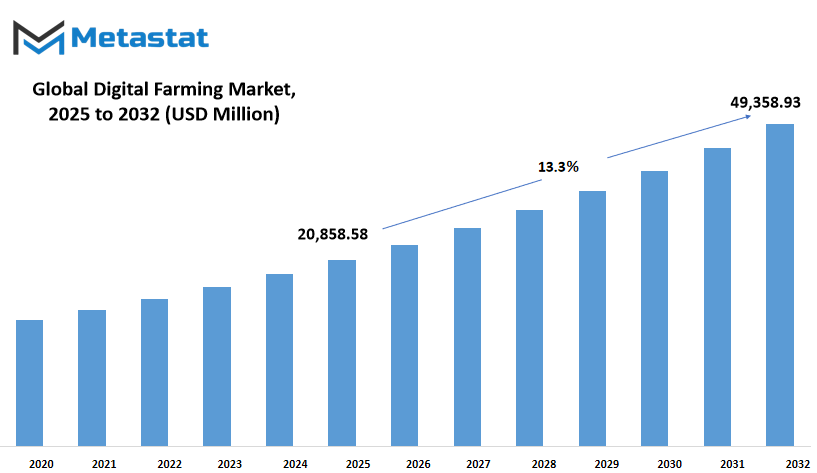
GROWTH FACTORS
The global digital farming market is also going to see its transformative change with the evolution of farm practices around the world due to technological advancements. With the population growth and rising demands for superior food production in a sustainable way, application of digital solutions is becoming paramount. Most significant drivers for this market are growing demand for traceable food solutions. The buzz now, transparency in food production results in higher demand for technology that can track and trace across the agriculture supply chain. This leads to accountability, further providing improved food safety in addition to sustainable farming practices.
Increased demand for IoT and Artificial Intelligence in agriculture is another fuel to the increasing global digital farming market. These technologies enable farmers to streamline operations by informing real -time information, future stating analysis and automatic responses. For example, IOT sensors can track soil conditions, weather and crop health and enable farmers to make decisions that increase productivity with minimal resource consumption. Again, AI-based equipment can predict crop diseases or recommend the best time for harvesting, which helps a lot to increase efficiency and reduce losses. These innovations are leading to an age when accurate farming is closed as an exception but rules. While highly promising, the global digital farming market is not immune either.
The initial cost of implementation is very high and keeps the majority of farmers, particularly those in low-income countries, away. The cost of the technology being so high combined with the regular maintenance just means that the cost of adoption is very high. Besides this, lower digital literacy among farmers will also limit broader use of these solutions. The key agricultural communities do not possess the requisite education or the necessary infrastructure to use digital solutions in a proper way. These are all creating impediments in the growth of the market. On the contrary, emphasis on sustainable agricultural methodologies are bringing promising chances for the global digital farming market in the upcoming years. As environmental issues multiply, strategies are being created by organizations and governments that maintain high productivity rates with minimized environmental effects.
Digital agriculture finds itself nicely positioned in these objectives since it does facilitate precision agriculture that conserves more water, chemical use, and yield enhancement in crop cultivation. Economic incentives related to sustainable farming and even greater awareness are going to offer momentum to propel this market forward. It has the potential of good growth into the Global Digital Farming industry with this technological advancement. If the appropriate investment in the affordability and education sectors is made, it will be revolutionary for the agricultural industry with the future of food security and sustainability.
MARKET SEGMENTATION
By Technology
The global digital farming market is revolutionizing the agricultural industry through the incorporation of advanced technology in conventional farming. Some of the challenges facing the industry are agriculture production, sustainability, and efficiency in agricultural production. Growing world population requires the most innovative methods of enhancing agricultural production. Digital farming is driven by the use of new technologies for agriculture.
Artificial Intelligence (AI), Machine Learning (ML), and Natural Language Processing (NLP) are a number of the major technological advances driving this area. They permit farmers to sift through huge statistics units, become aware of patterns, and make knowledgeable selections main to progressed crop yields and decreased waste. AI software can forecast climate situations, tune soil conditions, and identify pests, permitting them to act with utmost precision. And in addition, gadget gaining knowledge of permits for higher prediction through mastering over a steady stream of data in this kind of manner that farmed practice varies depending on conditions.
Internet of Things: The second vital component of virtual farming is the IoT, which hyperlinks several gadgets within the farm and sensors to allow actual-time facts concerning the environmental conditions, crop health, and equipment performance.
This connection allows farmers to reveal and alter their operations remotely, with better efficiency and diminished fees. For instance, IoT sensors in irrigation structures can make sure proper water utilization whilst avoiding overwatering of plants and saving it. Blockchain technology is likewise gaining traction inside the Global Digital Farming industry, particularly in terms of bringing transparency and agree with into the rural supply chain. Through secure recording of transactions and strategies, blockchain is able to track the course of meals products from the farm to the table. This will assist clients in making knowledgeable choices whilst allowing farmers to sell the first-class and authenticity of their products.
Big Data and Analytics are vital in presenting insights to farmers. Through the examination of both historical and live data, these tools enable farmers to select the most suitable planting strategies and predict demand, which controls risk. Analytics incorporation in farming systems results in intelligent decisions, which translates into greater productivity as well as reduced operating costs.
In the future, the global digital farming market is to transform the agricultural industry. These technologies will continue to develop and introduce new solutions to combat the problems like climate change and food security for the world. With increased access to digital tools, agriculture practices would be way more efficient, sustainable, and adaptive and create a bright future for agriculture.
By Product
The global digital farming market represents a move towards methods of agriculture that entail bridging the technology with tradition into efficiency and sustainability. Globally, on the scale of population growth, so does the demand for food production and their consumption, thus placing more pressure on agricultural systems both in terms of quantitative increase and resource saving. This industry is defining the future of agriculture in directions never thought possible before using agricultural equipment, drones, robots, and unmanned aerial systems. Further modernization of agricultural operations using agricultural equipment is ongoing.
Advancement in precision is observed in planting, watering, and harvesting using sensors, GPS, and IoT-operated equipment. This reduces wastage and raises the yield. For example, autonomous tractors with steerage systems are picking up speed. Such tractors, if utilized, will be very precise in fieldwork. Such kinds of innovations are not only bringing in productivity but are also cutting down the workforce, which is the requirement of the hour since individuals are not so inclined towards agriculture as an occupation. Drones, robots, and unmanned aerial vehicles are a few of the thrilling components of the global digital farming market. These technologies are assisting farmers in monitoring large tracts of land very quickly and effectively.
The technology-equipped drones, equipped with high-definition cameras and multispectral sensors, offer insights on crop health, soil health, and pest infestation at a very high level of detail.
Real-time information enables farmers to take specific action, minimize fertilizers and pesticides usage while maximizing crop quality. Robotics is beneficial in the case of repetitive activities such as weeding, planting, or even harvesting. These become less time-consuming and very scalable in agriculture. As far as the global digital farming market is concerned, its potential is in leveraging these technologies in more sophisticated means. Artificial Intelligence and Machine Learning would be a very critical segment – they would process huge data that digital tools will aggregate and give insights accordingly. The trend is set to go further in automation, with completely autonomous farms being a possibility.
Such developments are promising not only to make farming more efficient but also to focus on the environment by lowering emissions and saving water. The global digital farming market is transforming agriculture with cutting-edge solutions to address the scorching, global problems. By means of such advancements of agricultural machinery, drones, and robots, this is the path towards building a more sustainable future to be manufactured in the field of agriculture. By further development, the sector is guaranteed to deliver for an ever-increasing population's demands by protecting the planet.
By Infrastructure
The global digital farming market is adopting the future of agriculture through advanced technologies that will improve productivity and stability. Due to the increasing population, traditional farming methods will be replaced by high demand, thus focusing on challenges in resource loss, environmental impact and efficient production of food systems. A future point of view suggests the development of infrastructure, such as sensation and monitoring, communication technology, cloud-based data processing, and telematics or positioning systems will help redefine farming practices everywhere in the world.
The biggest importance is development that has been deployed in the deployment of sensing and monitoring technologies. These technologies allow a farmer to achieve real -time figures about soil health and conditions, crop conditions and environmental factors. They allow informed irrigation, fertilization and insect control decisions, and thus adapt to proper resource uses. For example, moisture-sensitive soil sensors can identify when water crops have to be spent on the least water. This innovation has helped to maintain agriculture but less expensive; Therefore, more efficient and profitable farming.
The digitization of agriculture is no longer behind other forms of communication technology. With its aid in offering comfortable connectivity from collecting data at centralized systems or mobiles levels at the form level, the farmers monitored farm far and wide and obtained up-to-date information and controlled automated and automated systems. In turn, decrease in human intervention leads to smooth operation towards increase in productivity.
Today, large volumes of statistics related to agriculture are being processed and handled thru cloud-based totally technology. This enables storing and reading records globally. Therefore, with these person-pleasant platforms, farmers can realise actionable insights on crop yield potential, come across hazard elements, and prepare for demanding situations ahead. Predictive evaluation is a want of the hour all of the greater in mild of weather change, which has a tendency to adjust the pattern of agriculture.
Telematics and positioning structures increase the accuracy in farming. GPS and other vicinity-based totally technology allow farmers to tune their equipment, locate optimization routes, and ensure correct placement of seeding and harvesting. They commonly enhance efficiency and lessen fuel intake as well as operation costs.
The similarly extension of virtual farming will retain to have implications for international meals protection and environmental sustainability. As a marketplace this is going to bring high-tech infrastructure into traditional practices, Global Digital Farming is ready to transform agriculture right into a technology that collaborates with nature in guide of human development.
By Application
The global digital farming marketplace is relatively growing because of the transformation of traditional agriculture via the mixing of technological improvements. This transformation is driven through revolutionary tools which are getting used to address the maximum critical challenges in food production. These technology enable farmers to make extra specific and informed choices that sell productiveness and sustainability. An growing worldwide population and rising concerns over resource performance retain to pressure demand for virtual farming answers.
Applications under the global digital farming market constitute the gamut of agricultural desires. Yield monitoring and mapping are an example; it shall we farmers examine the performance of the sphere with precision accuracy. The application makes use of satellite imagery, GPS technology, and facts analytics to allow farmers to decide the regions in which they may need intervention. This increases yields, even as optimizing input use like seeds and fertilizers minimizes waste. Smart crop tracking permits one to song in real-time the fitness reputation of plants. Advanced sensors may be capable of discover pests or diseases, or nutrient deficiency early earlier, thereby permitting corrective movements to be taken to avoid capacity losses.
Soil and fertilizer management is any other essential application that is reshaping agriculture. With digital tools, farmers can check soil great and nutrient stages extra efficaciously. This facts guides an appropriate application of fertilizers, reducing environmental effect and cutting expenses. Furthermore, the integration of clever irrigation monitoring systems has revolutionized water control. By the usage of IoT-based totally sensors and weather data, farmers can schedule irrigation cycles extra efficaciously, preserving water.
The global digital farming market cannot ignore essential components such as weather forecasts, which help to plan farm-based activities due to accurate predictions. It is through reliable weather data that adverse conditions, such as droughts or storms, can be reduced, which can protect crops and increase better management of a farm. Other applications such as automation and drone technology are carrying forward innovation in the field. These tools increase efficiency and reduce labor dependence, which is particularly valuable in addressing the workforce challenges.
Looking forward, the global digital farming market will probably continue to grow with technological progress. Artificial intelligence and machine learning and proper decision-making processes will carry forward, while blockchain technology can improve transparency of food supply chains. By embracing these advances, the industry promises to remove global food safety concerns, reducing environmental stress. The future of agriculture lies in the spontaneous integration of digital solutions, converting farming into a more efficient, durable and flexible region.
|
Forecast Period |
2025-2032 |
|
Market Size in 2025 |
$20,858.58 million |
|
Market Size by 2032 |
$49,358.93 Million |
|
Growth Rate from 2025 to 2032 |
13.3% |
|
Base Year |
2024 |
|
Regions Covered |
North America, Europe, Asia-Pacific Green, South America, Middle East & Africa |
REGIONAL ANALYSIS
The global digital farming market has gradually gathered momentum in a range of regions and is transforming the face of farming with high technology. Regional analysis forms a very crucial part of comprehension of the distinctive opportunity and challenge that each comes with, as geography influences adoption rate and areas of concentration of digital farm solutions.
United States, Canada, and Mexico are the leaders in North America as they have the most technology-driven developments and applications of digital agriculture practices. These countries have robust infrastructure and government policies favoring innovation. In these places, farmers are all the more applying precision agriculture equipment, data analytics, and mechanized equipment to boost productivity. United States is in the pioneering location, while Canada and Mexico have been constantly striving to further evolve digital farming programs, quite crop specific and environment based.
Europe: It comprises the more established and evolving digital farming market. United Kingdom, Germany, France, and Italy are utilizing existing agricultural infrastructure to host and incorporate recent technologies such as satellite imaging and IoT sensors. Sustainable practice: Farmers in Europe tend to pay more attention to resource optimization and minimizing waste. Moreover, all of the EU policies favoring ecological farming and optimizing farming drive the pace of digitalization in that market and its small markets in the Rest of Europe. Asia Pacific: Japan, China, South Korea, India. Here, the opportunities and challenges are uniquely blended. Exponential population growth, coupled with consistently rising food demand, has augmented demand for productive farming methods. Japan and South Korea are concentrating on high-end automation and robotics applications in farming, while others such as India and China support more cost-conscious solutions that are favorable to smallholder farmers. This diversity makes digital farming innovation specific to different scales of operations.
These two huge farm lands, Brazil and Argentina, are of great importance in the application of digital farming in South America because of the export-driven economy of these countries, and their focus is technology application to obtain higher yields, thus leading to competitiveness in foreign markets. These smaller countries of this continent are adopting modern modes of operation at an increased rate with the assistance of these digital technologies.
Lastly, the Middle East & Africa region, including GCC nations, Egypt and South Africa, is not lagging. It too has been fast moving in adopting digital farming. Indeed, it is a fact that these regions tend to have arid climatic conditions and limited water. Innovative products suited for such climates begin to take the lead position. Governments and private organizations in such places invest in technologies resulting in efficiency maximization and minimizing resources.
The global digital farming market is a patchwork of initiatives that will render agriculture smarter, more efficient, and capable of nourishing the world's increasing population.
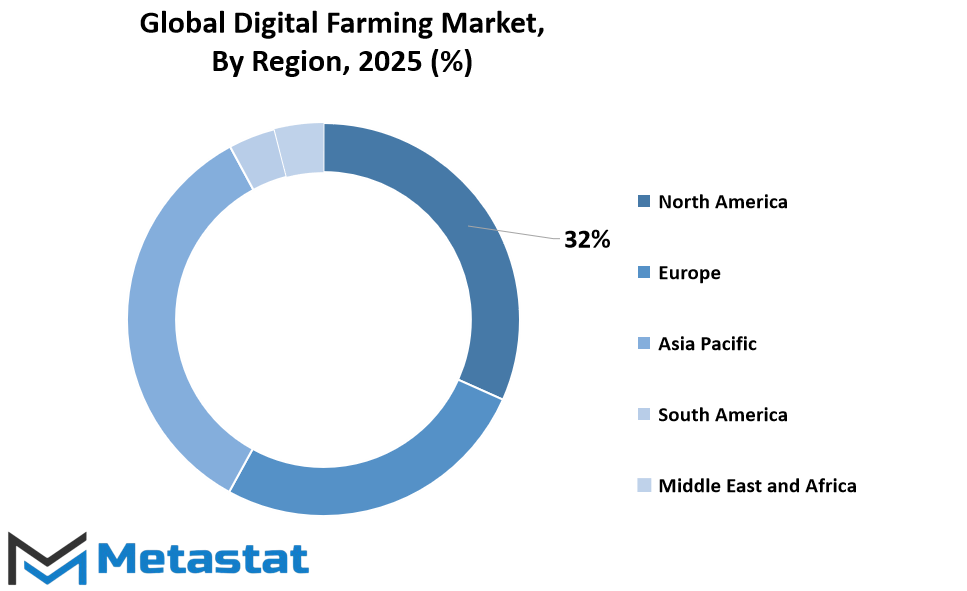
COMPETITIVE PLAYERS
The global digital farming market is expected to expand highly as agricultural technology changes the face of farming practices. As the demand for food produced sustainably grows, digital farming has emerged as a vital solution for addressing agricultural sector challenges. Innovative approaches characterize the market and ensure that farmers optimize productivity with minimal environmental impact. The top players are leveraging the application of smart technologies like sensors, GPS, drones, and data analytics to enable precision farming practices that can determine the actual state of health of the crops, condition of the soil, and altering weather trends.
A few of the industry top players are Deere & Company, Precision Planting, Inc., and Ag Leader Technology, which spur the integration of the cutting-edge solutions that promise greater efficiency. Firms like Trimble Inc. and Bayer AG are also contributing to the market by integrating artificial intelligence and machine learning into their platforms, thereby enabling better decision-making. By offering easier-to-use platforms and sophisticated agricultural machinery, such organizations are helping farmers achieve more with fewer inputs, a vital feature as global populations increase. In the future, the global digital farming market will likely transform at a fast rate with Internet of Things (IoT) technology integration. IoT technology enables smooth machine-to-machine and system-to-system communication, providing real-time tracking and timely actions.
For instance, PrecisionHawk and Farmers Edge Inc. are employing drone technology to offer aerial imaging and field mapping, which enables farmers to detect problems earlier before they turn into serious ones. Likewise, Kubota Corporation and CNH Industrial N.V. are leading machinery automation, minimising labor dependency while maximising precision. Sustainability is at the top of priority here, with firms such as Ceres Imaging and Hexagon AB working toward a sustainable, water-saving system. Such technologies positively influence farm profitabilities but also support global goals towards environmental development. In the future, with government focus and private investments increasingly prioritized for agricultural modernization, the competitive landscape should grow even more varied for potential in collaborative efforts and partnership building.
The global digital farming market will harvest fortunes in transforming the manner in which food is cultivated, controlled, and circulated. With some of the biggest names like CLAAS KGaA mbH, AKVA Group, and AGCO Corporation at its helm, the sector is all set to transform the new modes of farming by ensuring agriculture processes stay efficient, sustainable, and resistant to the threats dominating the future. With these developments, digital farming is anticipated to be heavily incorporated in agricultural plans across the world.
Digital Farming Market Key Segments:
By Technology
- AI/ML/NLP
- IoT
- Blockchain
- Big Data & Analytics
By Product
- Agricultural Equipment
- Drones/Robots/Unmanned Aerial Vehicles
By Infrastructure
- Sensing & Monitoring
- Communication Technology
- Cloud & Data Processing
- Telematics/Positioning
By Application
- Yield Monitoring and Mapping
- Smart Crop Monitoring
- Soil & Fertilizer Management
- Smart Irrigation Monitoring System
- Weather Forecasting
- Others
Key Global Digital Farming Industry Players
- Deere & Company
- Precision Planting, Inc.
- Ceres Imaging
- Ag Leader Technology
- Kubota Corporation
- CNH Industrial N.V.
- Topcon Corporation
- CLAAS KGaA mbH
- Trimble Inc.
- AGCO Corporation
- Bayer AG
- AKVA Group
- AgJunction Inc.
- Hexagon AB
- PrecisionHawk
- Farmers Edge Inc.
WHAT REPORT PROVIDES
- Full in-depth analysis of the parent Industry
- Important changes in market and its dynamics
- Segmentation details of the market
- Former, on-going, and projected market analysis in terms of volume and value
- Assessment of niche industry developments
- Market share analysis
- Key strategies of major players
- Emerging segments and regional growth potential



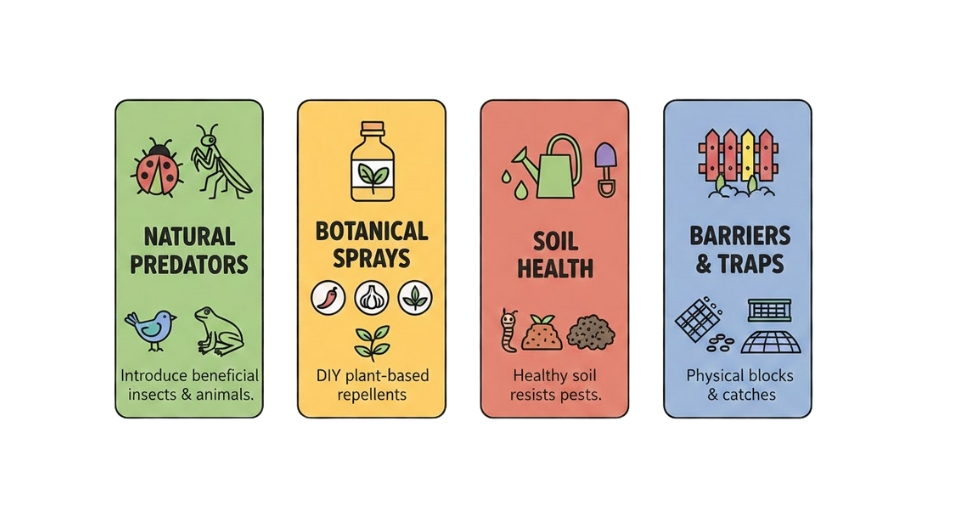
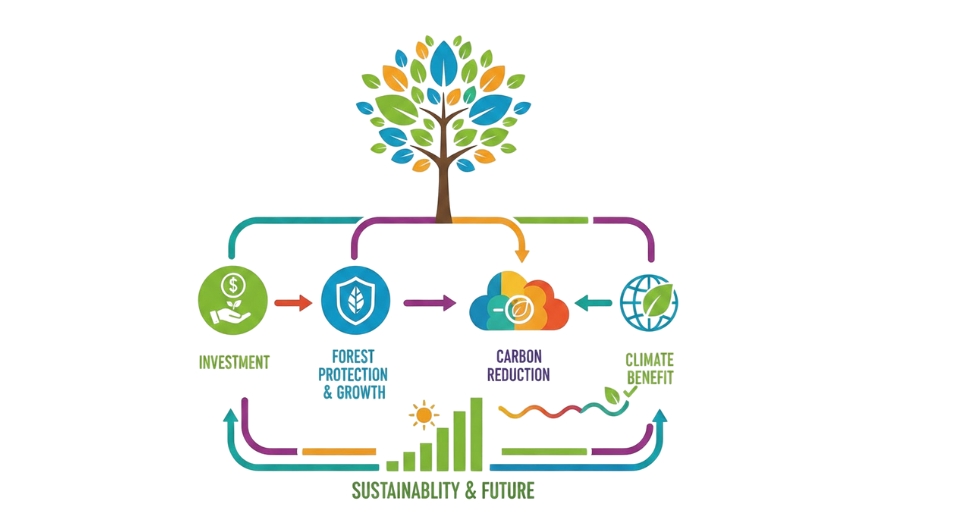
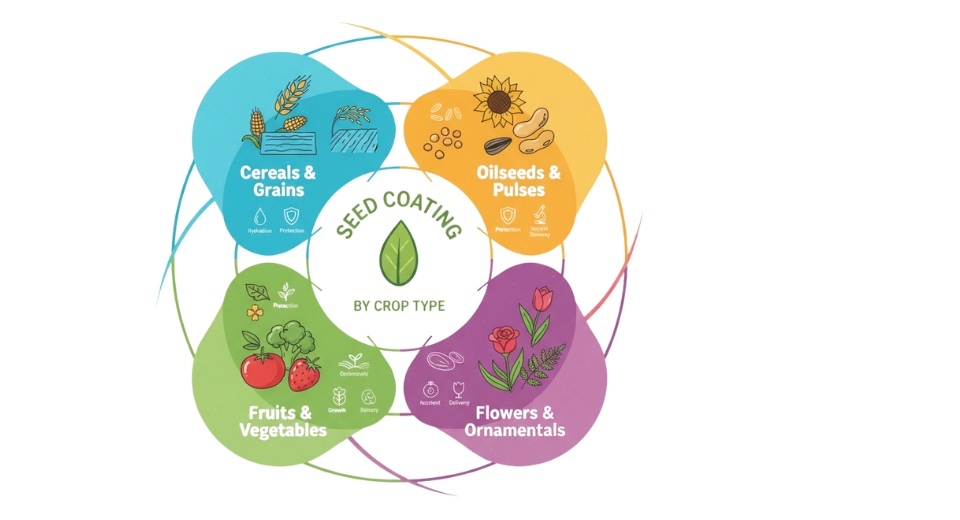
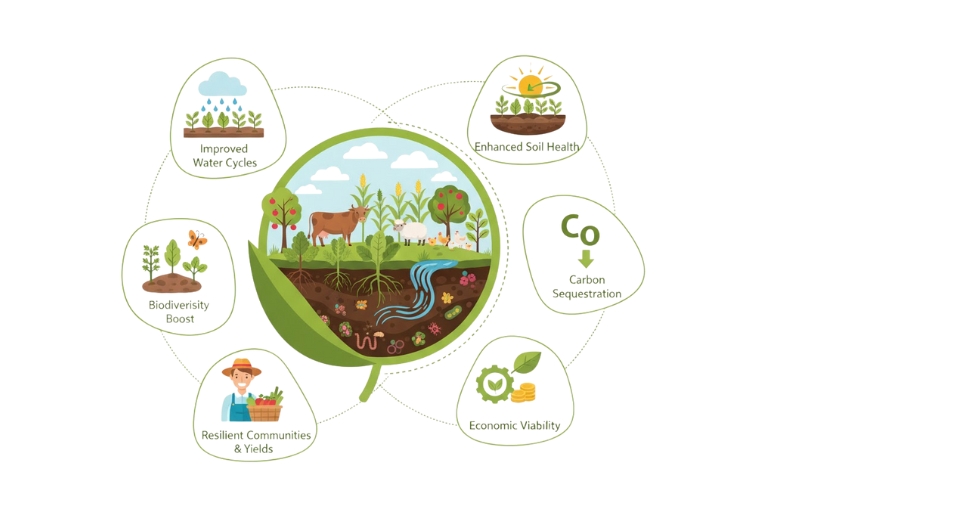

 US: +1 3023308252
US: +1 3023308252






